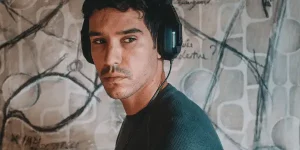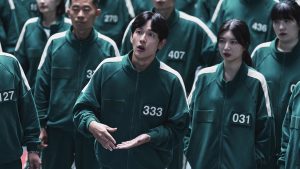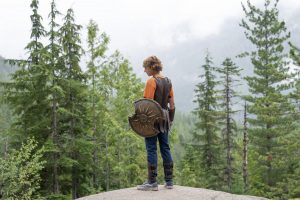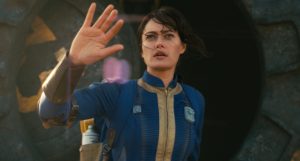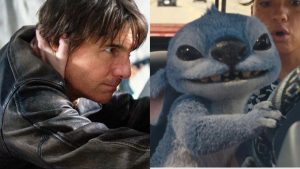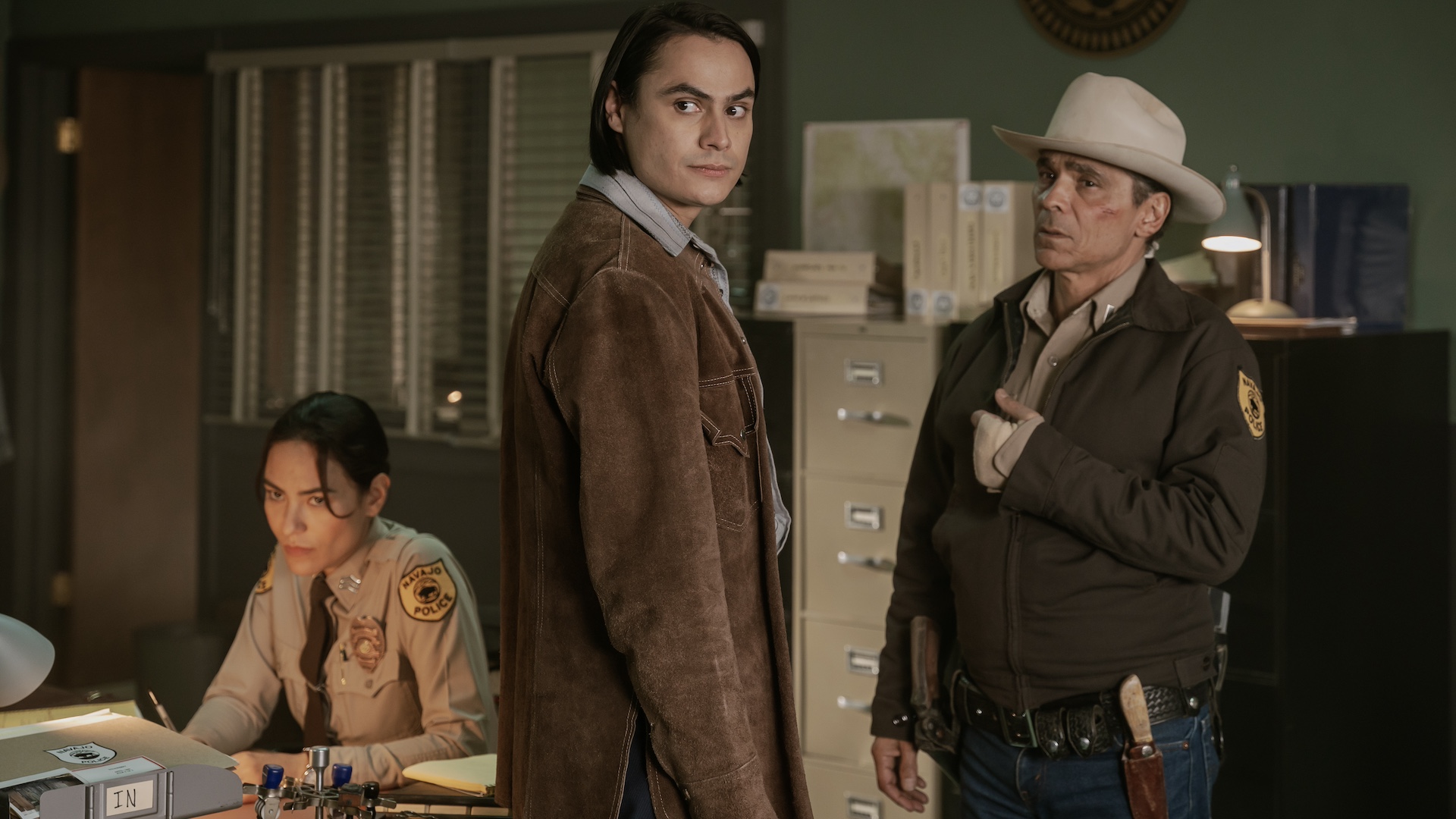
This article contains spoilers for Dark Winds seasons 1 and 2.
The rich mystery novels of Navajo lawmen Joe Leaphorn and Jim Chee have been entertaining readers for over 50 years, and in that time there have been several adaptations for the screen. In the early ‘90s, Lou Diamond Phillips, fresh off the success of Young Guns II starred as Jim Chee opposite Fred Ward. A decade later, PBS produced a miniseries entitled Skinwalkers: The Navajo Mysteries, which gave us a trio of Leaphorn & Chee stories starring Wes Studi and Adam Beach.
Throughout all the adaptations of Tony Hillerman’s stories, there have been a few key pieces pushing for the onscreen success of the work. The icon Robert Redford has been there every step of the way, backing any adaptation as a producer and staunch believer in the franchise. Another important figure is director Chris Eyre, who directed those aforementioned PBS productions, and found himself returning for AMC’s hit adaptation Dark Winds, which debuted in 2022.
The show, starring the gifted Zahn McClarnon as Leaphorn and Kiowa Gordon as Chee, has suddenly become one of AMC’s sleeper hits. With the first two seasons now available on Netflix, and a third season in post-production, Eyre and showrunner John Wirth took some time to reflect on what makes this show so unique and sought after.
Den of Geek: We’re seeing Dark Winds become even more widespread now because of its streaming availability on Netflix. What do you feel is the great appeal of the show and why do you think people are gravitating towards it?
JOHN WIRTH: I think it’s the only show of its kind being made in the United States. There are other shows about Natives or that have Native characters, but nothing like this and nothing like [Zahn] McClarnon. It’s a wonderful cast.
Doing a story about the Navajo in 1970 is intriguing to people and everybody at large enjoys a mystery or a detective story. There’s been a rich history of that sort of story being told on television, and we’re continuing along that road. But my impression of Netflix is, it’s really an invitation to see things from other cultures. In my day, coming up in television, we never had access to any of this stuff. But now I can see things from South Korea. I can see things from Ireland. I can see things from France, Germany, whatever. And here’s a show that you can see now and is from a part of the United States that is underserved on television.
CHRIS EYRE: Leaphorn and Chee have always been a great buddy cop dynamic, but it’s interesting, because it’s taken on a life that I didn’t expect with our show. It’s spread itself to include Sena [A Martinez] and Henry [Joseph Runningfox] – these gruff and tumble Western guys that grew up in the ’50s or ’60s, and they just have a different veneer to them. So even for those already familiar with the story, this whole idea of the buddy movie with Chee and Leaphorn has been expanded, and it’s much more of a community.
Chris, it’s a really interesting part of your career because you’ve been involved with the Tony Hillerman properties before, specifically about 20 years ago. Can you talk about how the environment of television has evolved in terms of representation and these stories becoming more mainstream?
EYRE: It’s been a great evolution to see. I think what happened was that “streamers” take more risks now compared to what I was able to do on PBS. Then there was the DEI movement and public awareness post-Standing Rock, which was in 2016. I was at the DNC and heard Kamala Harris. It was just incredible. “We’re not going back” – that adage is also adapted by audiences. Audiences are not going back. The inclusion of things way back in the ’90s, it’s all come full circle in terms of the availability of voices.
Dark Winds came at a time when I think the audiences were more amenable to this kind of thing. All of our main protagonists are Native American, and for me, that’s a watershed. These are the small hallmarks that make it. The fact that the principle four – Emma and Joe Leaphorn and Jim Chee and Bernadette – are all Native is just an amazing milestone.
With the end of the second season, to see Emma and Joe on the back of a motorcycle in Monument Valley, audiences realize this is just a drama about these characters and their lives, and you get to see a love story between two functional Native American people. I don’t think it’s ever been seen on screen, in television or film. So those small watersheds are the things that really make me think “Wow, this is such an opportunity.”
You touched on it already but with early 2000s television, creators made an effort to increase representation and we saw characters who represented diversity, but they were often archetypes or caricatures. How do we battle pigeonholing these characters, but at the same still address the culture which is so important to speak about?
EYRE: I think we do it with the writers. With our writers’ room, the majority are Native American, and to be a fly on the wall of the discussions between them is something that I will never forget, because it’s enlightening.
The show is really a contemporary Western with Native American lead characters wrapped in a murder mystery. With those staples, you can’t go wrong, but also, when you talk about the characters, all of them have dimension. We’ve had that for two seasons, and we continue that into the third. Joe Leaphorn is debating the morality of his own choices in season three. Not to give anything away, but he really has to make moral and ethical choices, and I think that’s where we all are.
It is about the three-dimensionality of these characters in the writer’s room, and then on set with the performers. Zahn [McClarnon], Kiowa [Gordon], Deanna [Allison] and Jessica [Matten], really give dimension to the characters. It’s a whole family here that really gives the dimension, and I think that’s what makes the difference.
John, when you were named showrunner, what did you feel were the responsibilities you had to the source material and the culture we’ve spoken about?
WIRTH: Well, I was a fan of the Tony Hillerman novels. I read them when I was a young man, and I was a mystery and detective novel reader, so I was very familiar with the story. I had tracked Redford’s involvement and his attempts 40 years ago to try to make a go of it.
When I talked to AMC about it in the beginning, [we recognized] these stories are challenging because, knowing what we know today, there’s some sense that Hillerman appropriated the Navajo stories to some extent. I’m not sure a white man could write this story today. So I see it as my responsibility to honor the books and the story that Hillerman wrote, and in a sense, reappropriate it back to the Navajo to make it palatable for a Native audience. That means approaching the story in a certain way, honoring the cultural sensitivities that that we run into.
So it’s been a real learning experience for me, and I’m just trying to tell a story that the broader audience will enjoy in terms of a detective show, and that the Navajo people will embrace in terms of their particular culture.
The show gives you an opportunity, especially when you consider the specific time period of the Hillerman novels, to talk about things like the Family Planning Services Act. Are there other aspects of the history of First Nations people that you want to explore or that you’re going to explore in season three?
WIRTH: Well, we have to speak about season three in the past tense, because we’ve already written it and we’ve already shot it. So, without spoiling anything, I’ll say that we took a deeper dive into Navajo culture and cultural mysticism. In the first season of the show, we dipped our toe in the water of this kind of material. There was a witch in the show, and that came from a place of wanting to explore Navajo mysticism. So we’ve gone in that direction a little more for season three.
But to your larger point, there are so many aspects of Native life, particularly the Navajo. They live on a massive reservation. They’re a country unto themselves, but they’re overseen by the federal government, and there are many issues – water, uranium, just to name a couple resources – and these are areas that are ripe for commentary.
If we have room in the story, we definitely will tap into some of those things, because I think it’s a great thing to use the show as a platform to inform and educate, even though the show is primarily for entertainment.
Listening Women and People of Darkness seem to be the novels that fed the first two seasons. Did the third season have influence from a specific work?
WIRTH: We drew from The Sinister Pig and Dance Hall of the Dead, and as a consequence, it’s a very ambitious story. It was quite a struggle trying to figure out how to connect the two so it didn’t feel like we were telling two independent stories, and I think we did a pretty good job of it. Dance Hall is widely viewed as one of Hillerman’s best novels, and Sinister Pig is widely viewed as one of his worst [Laughs].
I thought there were some very good things in Sinister Pig, which made it a good choice for us in season three, particularly because at the end of season two, Bernadette had left the Navajo Nation and the Navajo tribal police to go work for the Border Patrol. So Sinister Pig gave us a really good continuation of the story for this part of our series.
EYRE: I would say [season three] is more polished, it’s brighter, it’s bigger, there’s more excitement, more action. The performances are just electric, and we have scenes that are completely in Navajo between characters that go on for minutes. I think that’s enlightening, because you really get a sense of the language and culture.
Season three is great. I’m very excited about it.
Dark Winds season 3 is expected to premiere in 2025 on AMC. Season 1 and 2 are now available on Netflix and AMC+.
The post Dark Winds Producers on Season 3 And Why Leaphorn & Chee Stories Matter appeared first on Den of Geek.
